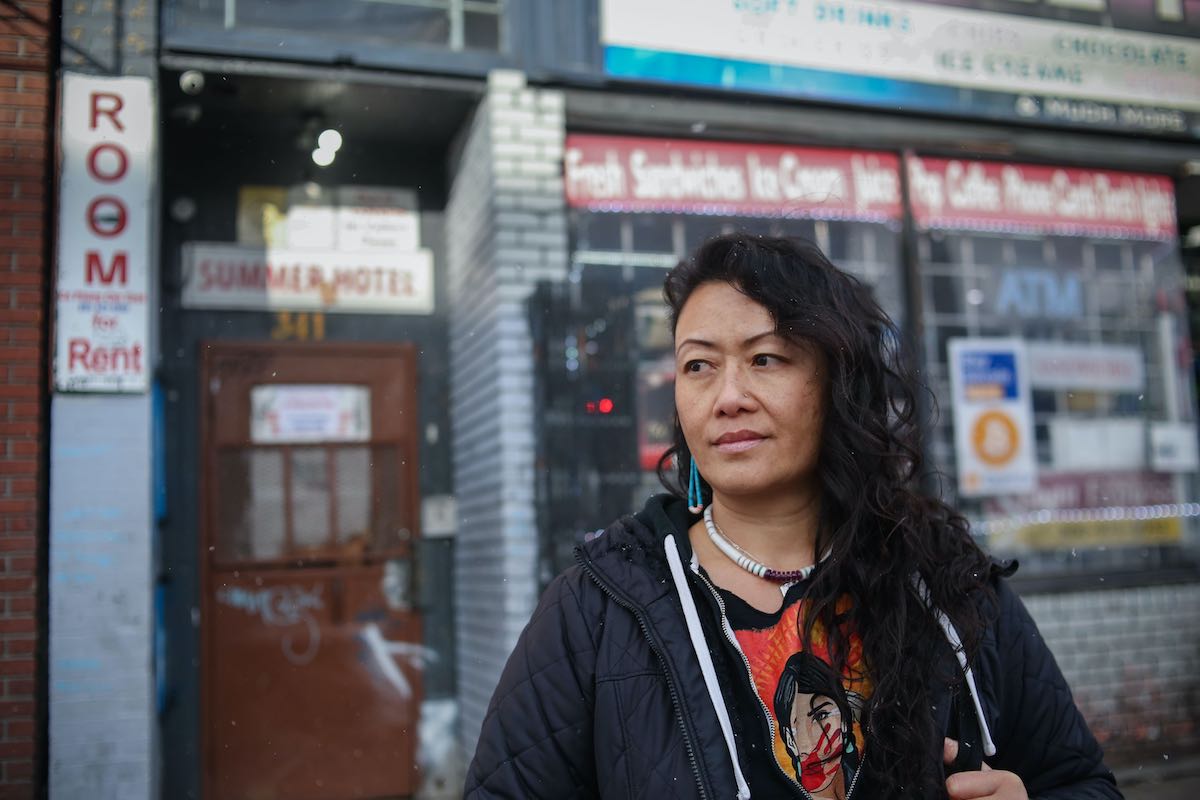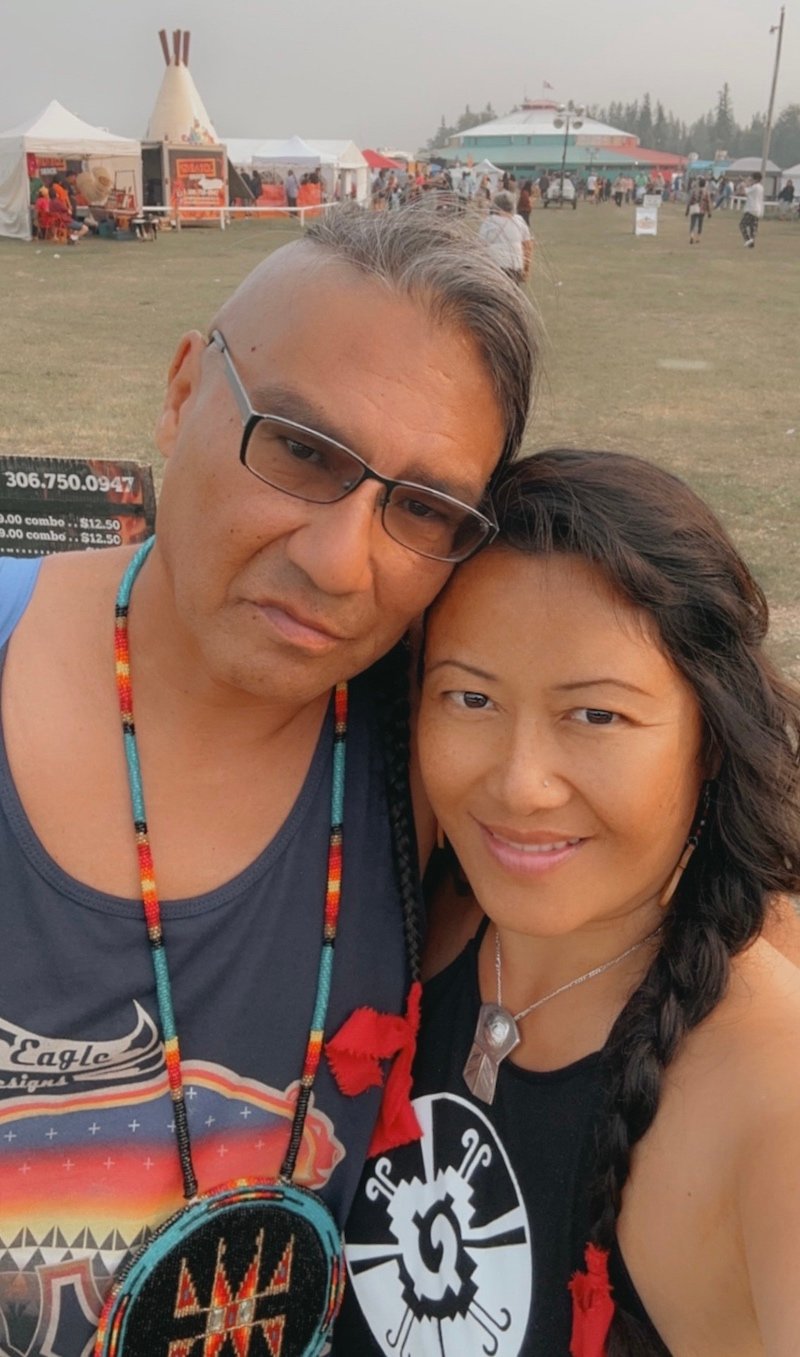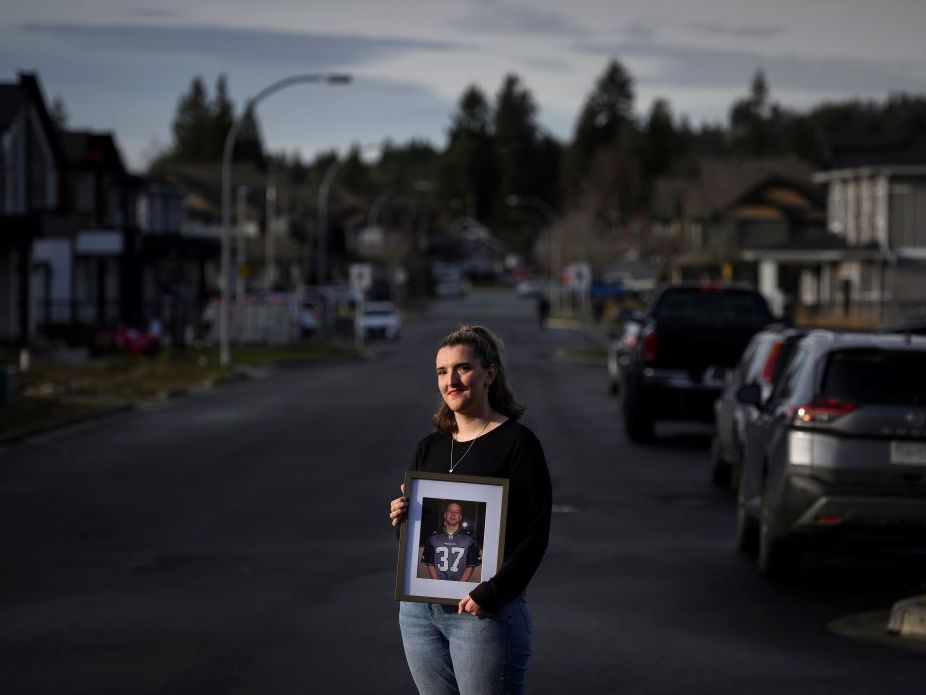When Kyle Johnson was taken off life support five days after losing consciousness, his lungs were full of blood clots. The 33-year-old had asthma and was found unconscious shortly after complaining that he couldn’t breathe.
Just two weeks earlier, on April 11, 2022, Johnson had been exposed to thick black smoke when a fire swept through the Winters Hotel, a single-room occupancy hotel, leaving two residents dead and the building a hollow shell. Tenants in the adjacent Gastown Hotel, where Johnson lived, had to be relocated for months because of smoke damage.
Johnson’s younger sister, Jessica Burton-King, hoped a coroner’s investigation would provide answers.
But when she got the coroner’s report, 14 months after her brother’s death, it said Johnson had died of an overdose, based on a potentially fatal level of fentanyl and methamphetamine found in his body when he was admitted to hospital.
Burton-King knew her brother had an addiction. After his death, she raised money for overdose awareness.
But the coroner’s report just left her with more questions. Although the coroner, Cynthia Hogan, wrote that the blood clots may have contributed to Johnson’s death, her report made no mention of Johnson’s recent exposure to smoke.
Burton-King was shocked to learn there had been no autopsy — the evidence of lung clots came from hospital tests while he was still alive. Johnson’s death was not included in a coroner’s inquest that examined the deaths of the two Winters Hotel residents.

“To me, that’s the job of a coroner: to do an autopsy and discover everything that could have led to someone’s death,” Burton-King said.
“That was very frustrating, especially to be getting the report [over] a year after his death and be like, ‘Oh, they didn’t actually fully investigate this at all.’”
Angela Gordon’s husband, Clayton Gordon, disappeared while he was on a trip to Vancouver on Aug. 10. She immediately travelled from their Victoria home to search for him.
Then she got a call from a Vancouver police detective. Clayton had been found dead days earlier, sitting slumped over on the bed in a stranger’s single-room occupancy hotel room. He didn’t have his phone, his shirt, his prescription Dilaudid pills or the belongings he’d brought from Victoria in a small rolling cart.
When Gordon learned Clayton had been found with his braid undone — something she says had cultural significance for him, and that he would never have allowed a stranger to touch — her suspicions grew.
The coroner told her toxicology testing showed Clayton had fentanyl, hydromorphone and cocaine in his body and that he’d been found holding a pipe. She was also told Clayton’s body was already at a funeral home.
Gordon was shocked.
“I asked, ‘Did you do an autopsy? You’re done with him already? You didn’t ask me anything,’” said Gordon. “They said, ‘No, we didn’t do an autopsy, because we went by toxicology.’”

Gordon believes police and the coroner made assumptions about her husband because he was a 54-year-old Indigenous man found dead in the Downtown Eastside. Gordon and a close friend of Clayton’s, Ben Gonzales, told The Tyee Clayton didn’t use illicit drugs.
BC is an outlier on drug death investigations
The way the deaths were handled is the norm in British Columbia, where the BC Coroners Service does autopsies for just 15 per cent of suspected overdoses and relies on toxicology testing to determine the cause of most of these deaths — 2,511 of them last year.
But it’s far different — and less rigorous — than in most provinces.
Like other coroner’s and medical examiner’s offices across Canada, the BC Coroners Service investigates all unnatural, sudden and unexpected, unexplained or unattended deaths. The office also makes recommendations to improve public safety and prevent other deaths.
But B.C.’s autopsy rate is far below that of most other Canadian provinces. In Ontario and Nova Scotia, autopsies are performed for nearly all suspected drug toxicity deaths. In all other provinces that responded to The Tyee’s requests for information, the majority of suspected overdose deaths receive autopsies.
It’s not just suspected drug toxicity deaths that have a low autopsy rate in this province. According to data collected by Statistics Canada, British Columbia has the second-lowest autopsy rate for all deaths; Quebec is the only other province that has a lower rate.
B.C.’s autopsy rate has also been falling, from 7.3 per cent in 2010 to 3.2 per cent of all deaths in 2022.
Matthew Orde, a forensic pathologist who has practised in B.C. and Saskatchewan, is concerned about B.C.’s low autopsy rate. He said the province is alone in relying on toxicology tests when it comes to overdose deaths.
“B.C. is the only jurisdiction I know in the developed world that has a policy of not performing autopsies as the standard practice in suspected drug overdose cases,” Orde said.
It’s also not considered best practice, Orde and other forensic pathologists say.
In a position paper published in 2020, the U.S. National Association of Medical Examiners convened an expert panel that recommended autopsy as “an essential component of investigating apparent overdose deaths.” The paper goes on to say that “the published evidence offers no substitute for autopsy” and recommends an autopsy whenever intoxication is suspected as the cause of death.
A 2019 study published in the American Journal of Forensic Medicine and Pathology that tested whether pathologists could determine the cause of death without an autopsy found pathologists got it right between 75 and 80 per cent of the time.
“Based on this study, we are satisfied that the accuracy provided from the extra work of autopsy justifies the additional time and resources,” the authors concluded.
‘We don’t immediately race to autopsy’
B.C.’s outgoing chief coroner, Lisa Lapointe, told The Tyee that the coroners service relies on expedited toxicology testing as well as information gathered at the scene of the death and interviews with family, friends and the deceased person’s doctor.
She said those practices produce accurate cause of death determinations.
In B.C., death investigations start when coroners travel to the scene of a death and examine the surroundings, conduct interviews and fully undress and examine the body, either at the scene or after the body has been moved to a morgue, according to Lapointe. The BC Coroners Service also has a special unit for suspected overdose deaths.
If all signs point to the death being caused by toxic drugs, coroners then order expedited toxicology testing, something Lapointe said is unique to B.C. She said the coroners service doesn’t automatically send these deaths for an autopsy, because experience has confirmed that toxicology testing is accurate enough.
If two rounds of expedited toxicology testing find drugs at amounts that “have been associated with lethal outcomes,” and drug use also matches all the other information the coroner has collected, then coroners will determine overdose as the cause of death.
“We don’t immediately race to autopsy for every death reported,” said Lapointe, who spoke to The Tyee in January, shortly before retiring from the BC Coroners Service after 13 years as chief coroner.
“An autopsy is a grossly invasive procedure. As you can imagine, we don’t rush to do that. We do it when it’s required. Many families do not want an autopsy — many Indigenous families in particular.”

Lapointe said the BC Coroners Service uses investigative techniques “that are going to get us the answers we need on a balance of probabilities.” She said that expedited toxicology also allows B.C. to quickly publish monthly overdose death data, giving an up-to-date picture to policymakers about the state of the overdose crisis.
Lapointe also said she had questions about the Statistics Canada data on autopsy rates.
But forensic pathologists say B.C.’s practices are leaving troubling gaps in death investigations.
Orde said toxicology results don’t provide the whole story. And he said examination of the body should be done by someone with medical training, in a setting like a morgue that has proper lighting and equipment.
“Typically the coroner in B.C. doesn’t have any significant medical training,” he said. “So the only examination of the deceased is typically being made by someone with only very limited medical training at most.”
Looking at the coroner’s report for Johnson’s death, Orde said it’s a case that would normally be sent for autopsy because either the blood clots in his lungs or the fentanyl found in his body when he was admitted to hospital could have caused his death.
Hogan, the coroner who signed off on Johnson’s report, wrote that the blood clots in the 33-year-old’s lungs would have made it harder for him to compensate “during a period of increased demand,” so she determined the blood clots were a contributing factor to his death.
Orde noted that the coroner’s report says fentanyl was found “within a range where therapeutic and lethal concentrations overlap” while “prior use” of methamphetamine was found, meaning meth may not have been a significant factor in the death.
“In this case, we don’t have the autopsy — we only have part of the picture,” Orde said.
Dr. Christopher Milroy, a forensic pathologist based in Ottawa, said that in Ontario, the default position is to do an autopsy for deaths that fall under the coroner’s jurisdiction. That’s because it is generally accepted that an autopsy is the most accurate method for determining cause of death.
“We have cases where the families aren’t keen and we will try and accommodate them, but many families want the reverse,” Milroy said.
Milroy said he found Lapointe’s statements about not wanting to upset family members odd. “You’re the leader of a death investigation system that thinks an autopsy is a violation of the corpse as a default position,” he said. “But the autopsy remains the central tool of death investigation.”
Lapointe disagreed, saying that while once, autopsies were considered the “gold standard” of death investigations, that is now changing.
No medical education required
British Columbia has a lay coroner system, meaning that coroners are not required to have medical degrees or training. Field coroners get on-the-job training and can draw on the expertise of forensic pathologists. Some coroners have more specific specializations, such as identification specialists who have training in anthropology and forensic science.
Saskatchewan, Quebec, New Brunswick, Prince Edward Island, the Northwest Territories, Yukon and Nunavut all use a similar model.
But in several Canadian provinces, medical training is considered necessary for death investigation work. Alberta, Manitoba, Nova Scotia and Newfoundland and Labrador have medical examiner systems; medical examiners must be physicians and are required to have training in pathology. Ontario has a coroner system, but all coroners must be doctors, including the chief coroner.
In the early 2000s, Ontario went through a reckoning of failures in death investigations. Shoddy work by pathologist Charles Smith had resulted in several wrongful convictions of parents and caregivers accused of killing or abusing children. Following an inquiry led by Justice Stephen Goudge, the Ontario government compensated people wrongfully convicted or charged in 19 cases that featured botched work by Smith.
Ontario created the separate Ontario Forensic Pathology Service to fulfil one of the recommendations of Goudge’s final report. That agency provides forensic pathology services — including autopsies — to the Ontario coroners service.
In B.C., it’s not a fear of wrongful convictions that haunts forensic pathologists. Instead, it’s a concern about what’s being missed.
“If we consider 100 cases, it’s only a handful of those 100 cases that would have other causes identified at autopsy,” Orde said.
“Those findings are of course of huge importance to family and friends, and indeed to all of us — especially if that death is a missed homicide.”
Overdose or murder?
Angela Gordon was left with so many questions about her husband’s death that she decided to try to find answers herself. She went to the SRO and spoke to the woman who lived in the room where Clayton had been discovered.

It was a frustrating conversation: Gordon said the resident told her Clayton had fallen asleep in her room and had been there all night. But that story differed from what Gordon said police told her: they said the woman came home to find Clayton dead in the room in the early hours of the morning. Gordon said police never recovered Clayton’s missing belongings, and she continues to find the circumstances of his death troubling.
“They never went back to find her and ask her any [more] questions,” Gordon said.
It’s common in the Downtown Eastside for people to question whether their loved one might have been intentionally given a lethal amount of drugs, a practice known as a hot shot.
While there’s abundant suspicion about whether some overdoses are really accidental, it’s almost impossible to prove that someone was given a hot shot, retired police detective Lorimer Shenher told The Tyee.
“It’s... so impossible to prove without a confession or without getting somebody recorded on a wiretap admitting to doing that to someone,” Shenher said, in part because different drug users will have varying levels of tolerance to the drug they’re accustomed to using.
Still, Gordon can’t help but wonder whether Clayton might have been intentionally drugged, then robbed.
Lapointe said it’s possible that homicides are being missed in B.C. and every other province, because coroners and medical examiners don’t investigate every single death.
“If you look at Dr. Orde’s argument that unless you do an autopsy, you may miss a homicide, we should have done 44,000 autopsies last year,” Lapointe said, referring to the total number of deaths in B.C. in 2023. “No province does that.”
But the risk of missing a homicide is not the only reason to conduct an autopsy when someone has died of a suspected overdose, said Milroy. Autopsies can help improve public health and future medical treatment.
Milroy said he’s had the experience of examining two deaths on the same day, both suspected overdoses. One was confirmed to be caused by fentanyl. But the second death was caused by diabetes, not an overdose, even though the person had a potentially fatal level of fentanyl in their body.
In another case, Milroy said, a man was found to have an extraordinarily high level of fentanyl — but his death had been caused by a gunshot, not an overdose.
From a public health perspective, it’s important be as accurate as possible about the cause of death, Milroy said. People who use drugs are often marginalized people who are also living with one or more other health conditions.
“At a global level, it [leads to] proper statistics, and it establishes that the cause of death was natural, not an accident, which is how you would classify a drug-related death,” Milroy said.
Autopsies can also help allay family members’ concerns and those of the wider public, Milroy said. But, he acknowledged, the sheer number of suspected drug toxicity deaths happening across North America means that coroners and medical examiners are struggling to keep up.
Burton-King and Gordon simply want to know what happened to cause the deaths of their loved ones.
“I didn’t even really think to ask the question ‘Was an autopsy done?’ because I had such a strong assumption that that’s what the coroner’s job was,” Burton-King said.
“It just kind of seems like they’re just going off the blood work and going, ‘Oh, there were drugs in the system, that has to be the cause of death.’
“There’s no further investigation, which leaves so many questions unanswered — and it doesn’t allow for proper closure.” ![]()
Read more: Health, Rights + Justice

















Tyee Commenting Guidelines
Comments that violate guidelines risk being deleted, and violations may result in a temporary or permanent user ban. Maintain the spirit of good conversation to stay in the discussion and be patient with moderators. Comments are reviewed regularly but not in real time.
Do:
Do not: